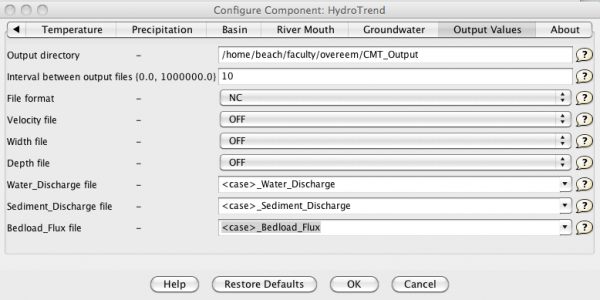Labs River Sediment Supply
River Sediment Supply Modeling with HydroTrend
We are using a theoretical river basin of ~1990 km2, with 1200m of relief and a river length of ~100 km. All parameters that are shown by default in the CSDMS Modeling Tool for the HydroTrend Model SetUp are based on a present-day, temperate climate.
>> Open Project: go to Group Courses, Select NCED2012 project.
>> Set a unique remote working directory for these experiments.
>> For this specific exercise we will be running HydroTrend in stand-alone mode. This means that you only drag the HydroTrend Component from the Component Palette into the Driver Palette.
>> HydroTrend will now be active in the CMT Arena. The HydroTrend Configure Menu is used to set the parameters for the simulations. You can set the parameters by going through the different tabs under the configure menu and subsequently run it by hitting the blue run button.
Exercise 1: Explore the base-case river simulation
>> Run a “base-case” simulation for 100 years at daily time-step.
>> To run the base case scenario. Make sure you have the input files and directories tab of the ‘Configure Menu” set to GUI. This means that the input to the model is being received from the GUI. Here you can specify your simulation name. The output files are then automatically tagged with this identifier.
>> Set a base case scenario for 100 years.
>> Specify a number of output files to generate after the simulation: these are netCDF files of water discharge, suspended sediment, and bedload. Switch the output interval to 1 (every timestep).
>> Now run the simulation!
Question 1a Calculate mean water discharge Q, mean suspended load Qs, mean sediment concentration Cs, and mean bedload Qb. Note all values are reported as daily averages. Q= m3/s, Cs=kg/m3, Qs =Qb = kg/s.
Question 1b Identify the 100-year flood event for this simulation. Plot the year of Q-data which includes the flood.
Question 1c Calculate the mean annual sediment load for this river system.
Question 1d To compare the mean annual load to other river systems you will need to calculate its sediment yield. Sediment Yield is defined as sediment load normalized for the river drainage area; so it can be reported in T/km2/yr. How does this compare to the present-day Mississippi River?


